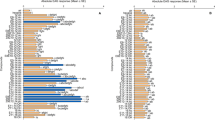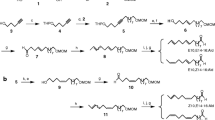Abstract
The behavioural significance of (Z)-9-tetradecenal to male H. assulta was tested by comparing the number of moths attracted to lures containing a standard synthetic female sex pheromone with lures in which (Z)-9-tetradecenal was also added. The standard pheromone mixture used contained 1000 μg (Z)-9-hexadecenal, 50 μg (Z)-11-hexadecenal, 300 μg (Z)-9-hexadecenyl acetate and 15 μg (Z)-11-hexadecenyl acetate impregnated on rubber septa. Addition of (Z)-9-tetradecenal to the standard pheromone was shown to significantly reduce the caught of male H. assulta when added in amounts greater than 10 μg or 1% of the major pheromone component in both field and net-house experiments. The reduction in catch was found to be dependent on the quantity of (Z)-9-tetradecenal added to the standard pheromone. The implications of these results on conspecific and inter-specific pheromone-mediated communication in H. assulta and related sympatric heliothine species is discussed.
Similar content being viewed by others
Abbreviations
- Z9-16:AL :
-
(Z)-9-hexadecenal
- Z11-16:AL :
-
(Z)-11-hexadecenal
- Z9-16:AC :
-
(Z)-9-hexadecenyl acetate
- Z11-16:AC :
-
(Z)-11-hexadecenyl acetate
- Z9-14:AL :
-
(Z)-9-tetradecenal
- Z9-16:OH :
-
(Z)-9-hexadecen-1-ol
- Z11-16:OH :
-
(Z)-11-hexadecen-1-ol
- RH:
-
relative humidity
References
Almaas TJ, Mustaparta H (1990) Pheromone reception in the tobacco budworm moth, Heliothis virescens. J Chem Ecol 16: 1331–1347
Almaas TJ, Christensen TA, Mustaparta H (1991) Chemical communication in heliothine moths. I. Antennal receptor neurons encode several features of intra- and interspecific odorants in the male corn earworm moth Helicoverpa zea. J Comp Physiol A 169: 249–258
Berg BG, Mustaparta H (1995) The significance of major pheromone components and interspecific signals as expressed by receptor neurons in the oriental tobacco budworm moth, Helicoverpa assulta. J Comp Physiol 177: 683–694
Christensen TA, Mustaparta H, Hildebrand JG (1991) Chemical communication in heliothine moths. II. Central processing of intra- and interspecific olfactory messages in the male corn earworm moth Helicoverpa zea. J Comp Physiol A 169: 259–274
Corey EJ, Suggs JW (1975) Pyrinium chlorochromate. An efficient reagent for oxidation of primary and secondary alcohols to carbonyl compounds. Tet Lett 31: 2647–2650
Cork A, Boo KS, Dunkelblum E, Hall DR, Jee-Rajunga K, Kehat M, Kong Jie E, Park KC, Tepgidagarn P, Liu Xun (1992) Female sex pheromone of oriental tobacco budworm, Helicoverpa assulta (Gueńee) (Lepidoptera:Noctuidae):Identification and field testing. J Chem Ecol 18: 403–418
Dunkelblum E, Kehat M (1989) Female sex pheromone components of Heliothis peltigera (Lepidoptera: Noctuidae). Chemical identification from gland extracts and male response. J Chem Ecol 15: 2233–2245
Gothilf S, Kehat M, Jacobson M, Galun R (1978) Sex attractants for male Heliothis armigera (Hdn.). Experientia 34: 853–854
Hall DR, Chamberlain DJ, Cork A, De Souza K, McVeigh LJ, Ahmad Z, Krishnaiah K, Brown NJ, Casagrande E, Jones OT (1994) The use of pheromones for mating disruption of cotton bollworms and rice stem borer in developing countries. Proceedings of the Brighton Crop Protection Conference — Pests and Diseases, 1231–1238
Hendrick CA (1977) The synthesis of insect pheromones. Tetra Report no. 34. Tetrahedron 33: 1–45
Hill DS (1983) Agricultural insect pests of the tropics and their control. 2nd ed. Cambridge Press, Cambridge
Houx NWH, Voerman S, Jongen WMF (1974) Purification and analysis of synthetic insect sex-attractants by liquid chromatography on a silver-loaded resin. J Chrom 96: 25–32
Kehat M, Dunkelblum E (1990) Behavioural responses of male Heliothis armigera (Lepidoptera: Noctuidae) moths in a flight tunnel to combinations of components identified from female sex pheromone glands. J Insect Behav 3: 75–83
Kehat M, Gothilf S, Dunkelblum E, Greenberg S (1980) Field evaluation of sex pheromone components of the cotton ballworm, Heliothis armigera (Hübner). Entomol Exp Appl 27: 185–193
Klun JA, Bierl-Leonhardt BA, Plimmer JR, Sparks AN, Primiani M, Chapman OL, Lepone G, Lee GH (1980a) Sex pheromone chemistry of the female tobacco budworm moth, Heliothis virescens. J Chem Ecol 6: 177–183
Klun JA, Plimmer JR, Bierl-Leonhardt BA, Sparks AN, Primiani M, Chapman OL, Lee GH, Lepone G (1980b) Sex pheromone chemistry of the female corn earworm moth, Heliothis zea. J Chem Ecol 6: 165–175
Masson C, Mustaparta H (1990) Chemical information processing of the olfactory system of insects. Physiol Rev 70: 199–245
McVeigh LJ, Campion DG, Critchley BR (1990) The use of pheromones for the control of cotton bollworms and Spodoptera spp. in Africa and Asia. In: Ridgeway RL, Silverstein RM, Inscoe MN (eds) Behavior modifying chemicals for insect management. Dekker, New York, pp 407–415
Minks AK, Cardé RT (1988) Disruption of pheromone communication in moths: is the natural blend really most efficacious. Entomol Exp Appl 49: 25–36
Park KC (1991) Composition and activity of female sex pheromone in the oriental tobacco budworm, Helicoverpa assulta (Guenée). Ph D dissertation, Seoul Natl Univ
Park KC, Cork A, Boo KS, Hall DR (1994) Biological activity of female sex pheromone of the oriental tobacco budworm, Helicoverpa assulta (Guenée) (Lepidoptera: Noctuidae): Electroantennography, wind tunnel observations and field trapping. Korean J Appl Entomol 33: 26–32
Raina AK, Klun JA, Lopez JD jr, Leonardt BA (1986) Female sex pheromone of Heliothis pfloxiphaga (Lepidoptera: Noctuidae): Chemical identification, male behavioural response in flight tunnel, and field tests. Environ Entomol 15: 931–935
Roelofs WL, Hill AS, Carde RT, Baker TC (1974) Two sex pheromone components of the tobacco budworm moth, Heliothis virescens. Life Sci 14: 1555–1562
Rothschild GHL (1978) Attractants for Heliothis armigera and H. punctigera. J Aust Entomol Soc 17: 389–390
Rothschild GHL, Nesbitt BF, Beevor PS, Cork A, Hall DR, Vickers RA (1982) Studies of female sex pheromone of native budworm, Heliothis punctiger. Entomol Exp Appl 31: 395–401
Shaver TN, Lopez JD jr, Hartstack AW jr (1982) Effects of pheromone components and their degradation products on the response of Heliothis spp to traps. J Chem Ecol 8: 755–762
Sugie H, Tatsuki S, Nakagaki S, Rao CBJ, Yamamoto A (1991) Identification of the sex pheromone of the oriental tobacco budworm, Heliothis assulta (Guenée) (Lepidoptera: Noctuidae). Appl Entomol Zool 26: 151–153
Teal PEA, Heath RR, Tumlinson JH, McLaughlin JR (1981) Identification of a sex pheromone of the Heliothis subflexa (GN.) (Lepidoptera: Noctuidae) and field trapping studies using different blends of components. J Chem Ecol 7: 1011–1022
Teal PEA, Tumlinson JH, McLaughlin JR, Heath RR, Rush RA (1984) (Z)-11-hexadecenol: A behavioural modifying chemical present in the pheromone gland of female Heliothis zea (Lepidoptera: Noctuidae). Can Entomol 116: 777–779
Tumlinson JH, Hendricks PE, Mitchell ER, Doolittle RE, Brennan MM (1975) Isolation, identification and synthesis of the sex pheromone of the tobacco budworm. J Chem Ecol 1: 203–214
Vickers NJ, Christensen TA, Mustaparta H, Baker TC (1991) Chemical communication in heliothine moths. III. Flight behaviour of male Helicoverpa zea and Heliothis virescens in response to varying ratios of intra- and interspecific sex pheromone components. J Comp Physiol A 169: 275–280
Wall C (1989) Monitoring and spray timing. In: Jutsum A, Gordon RFS (eds) Insect pheromones in plant protection. Wiley, Chichester, pp 39–66
Author information
Authors and Affiliations
Rights and permissions
About this article
Cite this article
Boo, K.S., Park, K.C., Hall, D.R. et al. (Z)-9-tetradecenal: a potent inhibitor of pheromone-mediated communication in the oriental tobacco budworm moth, Helicoverpa assulta . J Comp Physiol A 177, 695–699 (1995). https://doi.org/10.1007/BF00187628
Accepted:
Issue Date:
DOI: https://doi.org/10.1007/BF00187628




